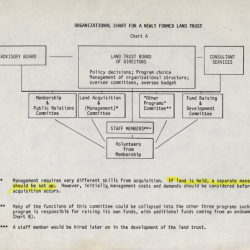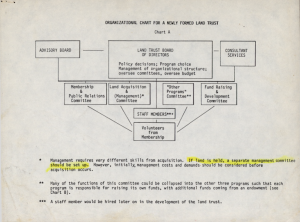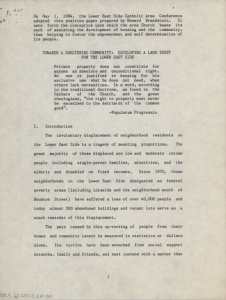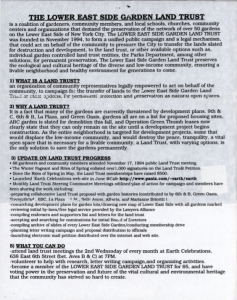September – The Role of Land Trusts in the Lower East Side

29 September 2021
By John C. Harris
National Public Lands Day is celebrated annually on the fourth Saturday of September with initiatives centered on conservation and natural resource management. While every weekend MoRUS volunteers commit themselves to “garden clean up days” to assist with the maintenance of gardens in the neighborhood, this year MoRUS will celebrate the occasion with a blog post that uses items from the collection to examine the role of land trusts in the Lower East Side. When one thinks of public land the images that come to mind are often national parks, state managed forests, or even monuments. And those assumptions are correct. Essentially public land consists of locations which are regulated by a civic body. Land Trusts differ slightly from public land in that they are typically managed by a private or non-profit group. The goal of most land trusts is to promote public use rather than private development.
What does an environmental group started in 1970s San Francisco, the Catholic Church, and a group of guerrilla gardeners have in common with one another? They each sought the land trust model in response to the spatial deconcentration and divestment which left the social and physical infrastructure of the neighborhood bare. As the community cultivated gardens out of what were once rubble strewn lots, land trusts played a vital role in the contentious battle of ownership over what was quickly becoming prized land for development for the city and real estate developers. The archives of Green Oasis Community Garden/Gilbert’s Garden on deposit at the Museum of Reclaimed Urban Space reveal documents from the Trust for Public Land (TPL), Lower East Side Catholic Area Conference, and Lower East Side Garden Land Trust which helped complicate the understanding of land access and ownership throughout the later half of the 20th century.

(Organizational Chart for a Newly Formed Land Trust, Archives of Green Oasis Community Garden/Gilberts Garden at MoRUS)
The Trust for Public Land was started in San Francisco in 1973 and works with community groups, and government agencies to acquire and preserve open space to serve human needs, share knowledge of non-profit land acquisition processes, and pioneer methods of land conservation and environmentally sound land use. By 1978, the TPL began working in New York City, establishing itself as a national force able to meet the unique needs of a variety of communities. TPL’s initial goal in New York City was to help community gardens gain permanent or long term control of the contested garden sites. Their efforts were quickly tailored to the needs of New York City’s community gardens to assist with not-for-profit incorporation, tax exemption, and other kinds of management help. In 1986, a grant from the Mary Flagler Cary Charitable Trust provided TPL with the financial ability to address these organizational development issues more effectively. The TPL established the Neighborhood Open Space Management program (NOSM) and provided garden groups consulting services as well as documents like “Forming a Land Trust” and the “Land Trust Management Handbook” to enhance their stewardship of the land. These forms of assistance, as well as financial support, from the Trust for Public Hand helped groups like Green Oasis Community Garden organize so that it was able to more effectively provide a range of community services ranging from plot cultivation, workshops, and local productions. The Mary Flagler Cary Charitable Trust partially funded The Enchanted Garden, a children’s theater production directed by Green Oasis founder Reynaldo Arena which starred the local neighborhood children! The TPL was critical to bolstering the gardens around the city at a critical time. Their influence and direction in the formative years of the garden helped ensure their long lasting success and established the gardens as pillars within the community. This elevated perception of the gardens helped to preserve the community spaces in the ensuing legal battles of the 2000s which challenged their legal status.
By the time the TPL began its projects in New York City, the local arm of the Catholic Church realized it also needed to assist the neighborhood in new ways that empowered the community. On May 1, 1984, the Lower East Side Catholic Area Conference adopted a paper titled Towards a Sheltering Community: Developing a Land Trust for the Lower East Side authored by Howard Brandstein (now executive director of Sixth Street Community Center) as their position moving forward to address the displacement of Lower East Side community members. In his paper, he justified the church’s commitment to land trusts asserting that “the free hand of the market without ethical guidance stands in direct contrast, for example, to the hand of Jesus in the miracle of the fish and loaves.” Brandstein argued that the functions of a land trust as both organizing tools, and an entity that defines legal and political relationships in a not for profit context provided an ethical response to the exploitative development occurring in the neighborhood. Although the collection at hand does not relay any examples of action on behalf of the Church, its stated devotion to this alternative land management process reveals the community wide commitment to the system of land trusts.

(Toward A Sheltering Community, AGOCG/GG at MoRUS)
It should be noted that powerful external groups like the Trust for Public Land and the Catholic Church were not the only ones engaged with the land trust process. An aspect unique to the Lower East Side is its commitment towards, and success with, organizing at the grassroots level. Smaller, more community based groups also perceived land trusts as a viable option to preserve the newfound open space derived from the mismanagement of private landlords. In November 1994, The Lower East Side Garden Land Trust was founded by participants including garden members, local schools, and community centers seeking to preserve the neighborhood’s green network. Their stated goal was to “preserve the ecological and cultural heritage of the diverse and low income community, [and to ensure] a livable neighborhood and healthy environment for generations to come.” According to the group’s correspondences, leases with Operation Green Thumb, the city’s access point into the gardens, were changed and stated that the gardens were allowed to operate until a development project was started on that land. In response LESGLT organized itself. That year, participating gardens in the LESGLT used community events such as the Winter Pageant and Rites of Spring to enlist over 1,000 signatures to petitions and raise hundreds of dollars at a time to ensure the voice of the community was represented in the discussion over how land was used, resided over, and developed in the neighborhood.

(LESGLT Brochure, AGOCG/GG at MoRUS)
While the role that a select group of larger organizations played in the preservation of the neighborhood is key to its development, the movements which were initiated and sustained within the Lower East Side are critical to the story we tell at the Museum of Reclaimed Urban Space. Our growing archives preserve the ephemeral record of initiatives like the land trust movement which pollinated the neighborhood in the 1980s and helped preserve those spaces into the 21st century.
